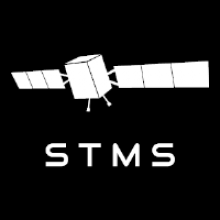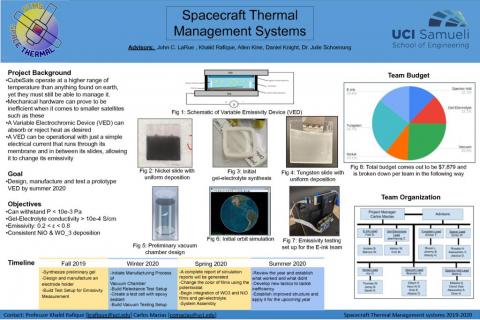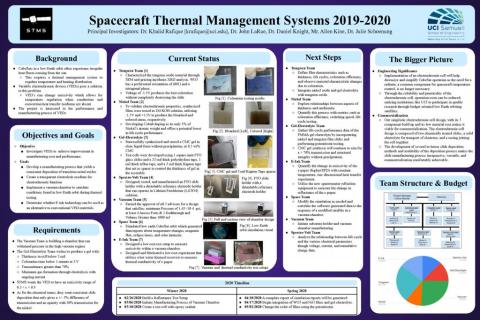Spacecraft Thermal Management Systems
Spacecraft Thermal Management Systems (STMS) is an undergraduate, interdisciplinary research/design project that works to develop an electrochromic cell for space applications for Cube and Nano Satellites. This device will act as a method of controlling heat from going into and out of the satellite through a color change, which affects how much heat is being let in. Such spacecraft are not exposed to a constant heat flux from the sun as a result of low Earth orbit. This device is special since the amount of color change can be modified to let in the proper amount of heat necessary for the spacecraft to operate.
The device works through a redox reaction pairing of nickel oxide and tungsten trioxide based films. When electrons are removed from each film, the nickel oxide will color to a dark brown and the tungsten trioxide will bleach to a clear coloration. Similarly, when electrons are added to each film, the nickel oxide will bleach to a clear coloration and the tungsten trioxide will darken to a blue coloration. When these thin films are combined, both pairs will either darken or bleach at the same time, forming the device.
- Background
-
CubeSats in a low-Earth orbit often experience irregular heat fluxes coming from the sun
- This requires a thermal management system to regulate temperature and heating distribution
-
Variable emissivity devices (VEDs) may pose a solution to this problem
- Controlling emissivity allows for temperature regulation when conduction and convection heat transfer mediums are absent
- The project is interested in the performance and manufacturing process of VEDs
-
CubeSats in a low-Earth orbit often experience irregular heat fluxes coming from the sun
- Goal and Objectives
-
Objective
- Investigate VEDs in the hopes of achieving improvement in manufacturing cost and performance
-
Goals
- Develop a manufacturing process that yields a consistent deposition of transition metal oxides
- Create a transparent electrolytic medium for electrochromic function
- Implement a vacuum chamber to simulate conditions found in low-Earth orbit during thermal testing
- Determine whether E-ink technology can be used as an alternative to conventional VEDs in space
-
Objective
- Project Manager
- Carlos Macias [comacias@uci.edu]
- Advisor
- Professor Khalid Rafique [krafique@uci.edu]



